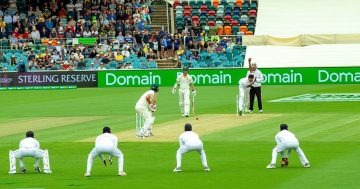
The crowd on the Hill at the SCG in 1983. Photo: Wikimedia Commons.
Did anyone notice the international cricket season kicked off this week?
Very few did, it appears, with the Melbourne Cricket Ground only a quarter full as Australia took on Pakistan on a Monday in a match that was scarcely advertised.
The home side then rested its best player for the third and deciding clash to ensure the series fizzled out as meekly as it began.
It’s clear our supposed national sport has lost its allure.
To bring back the fans, we need to revert to an old-style Channel Nine commentary team, revive the sing-a-long summer anthem, restrict ourselves to one national team, cut the meaningless matches and scrap the DRS.
Here are five reasons why cricket was so much better in the 1980s.
Commentary now sucks
It’s hard to admit, but the era of the pale, stale and male commentators provided far more banter for viewers than we have now.
Bill Lawry said black, as Tony Greig said white, Richie Benaud’s dry wit, and Geoffrey Boycott’s provocations kept us all entertained if the on-field happenings were slow and lopsided.
But now, diversity and inclusion have replaced merit when selecting those in the box, and that’s killing all the fun (save for Kerry O’Keeffe).
Worse still, commentator gigs are now the next career step for the immediately retired player. David Warner may have been a great batsman, but is anyone really interested in hearing his analysis?
“C’mon Aussie” song is gone
A different version of the classic “C’mon Aussie C’mon” song used to be introduced to us at the start of the season. It was the distinctive anthem that pumped us all up for the upcoming summer. It even came with a “goodness gracious me” line when the Indians toured in 1980.
We’re now in an era with 10 times as many people employed in communications and marketing. But for whatever reason, messaging is worse than ever. There seem to be fewer ads promoting cricket, and those aired are generic and boring.
Too much cricket
In the 1980s, there was little cricket for Australian fans to watch between March and November. By the time the season started, we’d have been starved of the sport and hungry for action.
But cricket is now on every month of the year.
In what used to be the off-season, you’ll find a tour to Sri Lanka, a T20 tournament in Dubai and probably even a World Cup (four yearly tournaments that have somehow become annual events). There are so many series that top players are often rested (as they were this week), devaluing the contest. If you can’t put your best squad on the paddock, you’re better off not playing at all. Quantity doesn’t equal quality. Fans and players need the chance to miss the game.
Three sports, three teams
It was much easier to follow the Australian cricket team in the 1980s as there was just one team. We’d have test matches and one-day internationals, but both squads were largely the same, save for a couple of limited over specialists like Simon O’Donnell and Tom Moody.
Nowadays, there are three separate teams for the three forms of the game (including T20s) and you really can’t keep track of who is in which team. It’s much harder to gain familiarity or empathy with your national colours when the names keep changing so rapidly.
DRS
Who decided a sport that goes on for seven hours in a day needed to be stretched out a little?
Seeing the umpire’s finger go up used to give fans that feeling of pure ecstasy or deathly dread. That’s been taken away now as it seems every second decision is reviewed, leaving us to wait several minutes as every angle and permutation is examined.
We used to watch 90 overs by 6 pm, but we’re now lucky to see 75. That’s less value for money and more time wasted.
I think most cricket fans would like to DRS the DRS system and rule it OUT.

















